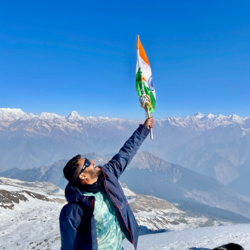Nag Tibba Trek which lies in the Lower Himalayan Range near Mussoorie, is a good weekend hike for anyone wanting to take a breather from their daily routine. The trek offers gentle slopes making it an ideal option for people looking to do their first Himalayan Trek. The trek begins from a small hamlet which goes by the name of Pantwari. The circular itinerary that ends at the village of Auntar is short, yet extremely rewarding. Walking through the dense forest on the Auntar side is a treat every hiker is bound to cherish.
One of the many highlights of this trek is the variety of flora found here. Often we get so engrossed in the beauty of the trek that the trees & bushes that we come across go unnoticed. To honour and celebrate these beauties, we are listing 27 of the most commonly found trees here with some of their common uses that make them a vital part of everyday living for the locals in the region.
1. भीमल (Bhimal) : Used for feeding cattle. Also used in making Ropes & Mattress.

2. खड़की (Khadki) : Used for feeding cattle. It blossoms in April.

3. चुल्लू (Chullu) : The fruit is eaten. The seed is used for making oil. This oil is used in cooking. It is also used in hair care.

4. बुरांश (Buransh or Rhododendron) : The state tree, used for making juice. It is known to help control bad cholesterol.

5. बांझ (Baanjh) : Used for feeding cattle and making firewood.

6. तूण (Tun) : Wood is used in building houses and furniture.

7. शीर्श (Shirsh) : Poisonous. Cattle can die if they eat the new leaves (which come in March/April).

8. मोदू (Modu) : Fruit is eaten. Tastes sweet and sour.

9. अंयार (Anyaar) : Leaves used as fodder for goats. Dry leaves are laid down in domestic animal shelters to keep them warm.

10. पदक (Padak) : Used in performing rituals. Branches are considered pious/holy.

11. लगले (Lagle) : A vine which climbs by winding itself to other trees. Eats away the main plant.

12. फ़र्न (Fern)

13. जंगली पालक (Jungali Palak)

14. पुदीना (Pudina) : A Herb used in making drinks & medicines

15. काली घास (Kali Ghas) : The juice which comes after meshing it, is used to apply on wounds. Helps them heal faster.

16. जंगली कपास (Jungali Kapaas) : The white layer is used in Hooka. It is put above Tobacco. Helps it get warm & burn faster. Mostly found on rocks.

17. कंडोन (Kandone) : A type of grass used as fodder for cattle.

18. काल्टी (Kaalti) or बिच्छु घास (Bichhu Ghas) : Used in making vegetable. Stings if touched.

19. झूला घास (Jhula Ghas) : Found on the trees. Used for making “Mehandi”

20. खरसू (kharsu) : Used as fodder for cattle

21. चिरायता (Chiraytha) : Smells very strong

22. पथ्थर चटटी (Paththar Chatti) : Its juice is used as medicine to treat kidney stone. Grows on rocks

23. गूम (Goom)

24. मरचुली (Marchuli) : Goats love eating it

25. आड़ू (Aadu) : Fruit is eaten. Fruit ripes in July/August

26. फेडू (Phedu) : Fruit is eaten. Leaves are used as fodder

27. सप्रेस (Sapres) : Used for making Houses & furniture

We hope this guide helps you identify the plants on the trek and make the hike a bit more interesting for you!
This article was originally written by Bikat Adventures on 07-01-2017.
It was edited and updated by Neeti on 02-11-2023.






